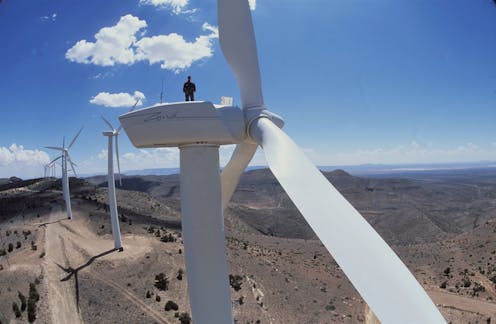Who benefits from renewable energy subsidies? In Texas, it's often fossil fuel companies that are fighting clean energy elsewhere
- Written by Nathan Jensen, Professor of Government, The University of Texas at Austin College of Liberal Arts

Texas is known for fiercely promoting its oil and gas industries, but it’s also the No. 2 renewable energy producer[1] in the country after California. In fact, more than a quarter of all the wind power produced in the United States in 2021 was generated in Texas.
These projects benefit from a lucrative state tax incentive program called Chapter 313[2]. That incentive program expires on Dec. 31, 2022, and the rush of applications for wind and solar energy projects to secure incentives before the deadline is providing a rare window into a notoriously opaque industry.
By reviewing the applications and ownership documents, we were able to track who actually builds and owns a large portion of the nation’s renewable energy, when and how those assets change hands, and who ultimately benefits from the tax incentives.
The results might surprise you. The majority of utility-scale solar and wind energy projects in Texas aren’t owned by companies focused on renewable energy – they’re owned by energy companies or utilities that are better known for fossil fuels, including some that have aggressively opposed renewable energy[3] and climate policies in other states and nationally.
The policy implications of these findings are complex. While these subsidies might lead some energy companies to reduce their greenhouse gas emissions, they also can allow energy companies to continue polluting from existing fossil fuel assets while collecting the subsidy benefits.
A subsidy program that saves companies billions
Chapter 313 limits how much companies have to pay in property taxes for schools if those companies build infrastructure and agree to create jobs. The Texas Legislature passed it in 2001 when a number of large companies, including Intel and Boeing, were considering Texas for an investment location.
Companies using this program can save billions of dollars[4] in local property taxes. However, investigations have revealed[5] high costs per job and minimal requirements for companies. The state’s school funding system[6] also suffered.
The program wasn’t renewed, but companies that applied for the incentive by Aug. 1, 2022, could grandfather in their investments for 10 years of tax benefits. That led to the rush of applications[7], including for wind and solar projects.
Who’s proposing renewable energy projects?
We reviewed 191 wind and solar project applications[8] filed in 2022. If built, these projects would almost double the number of renewable energy projects in Texas[9].
It is notoriously difficult to track the owners of renewable energy projects in the U.S., because most are structured as limited liability companies[10], or LLCs. However, the application for Texas incentives requires not only information on the owner, but also a signature of an individual representative of the owners. That provides a glimpse into the impact that subsidies can have and who benefits.
We found that just over a third – 69 out of 191 proposed projects – are owned by renewable energy companies, such as Danish company Ørsted and Recurrent Energy, owned by Canadian Solar.
Over half the proposals – 101 – were submitted by energy companies known more for oil and gas, or utilities with fossil fuel assets. This includes the renewable energy subsidiaries of oil supermajors such as Total and BP, and utility owners including EDF, AES and Engie, all of which are major global players.
Some project applications came from investment groups such as DeShaw Group, Cardinal Investment Group and Horus Capital. Apex Clean Energy, a renewable energy subsidiary of the major investment manager Ares Management, frequently showed up in applications.
New owners take over
The proposed projects provide a snapshot of the renewable energy projects’ developers – but what happens after these projects are built?
To figure that out, we also looked at all renewable energy projects completed in 2020 and 2021 that participated in the Chapter 313 incentive program.
To our surprise, almost half of the projects built in 2020 or 2021 had changed hands by 2022. Some were due to company acquisitions. Many other projects were sold.
This changed the composition of owners. While renewable energy companies owned roughly half the projects at the application stage, by 2022, two-thirds of the projects were owned by utilities and energy companies with fossil fuel assets.
The original developers may have benefited from the first year or so of the tax break, but the new owners are poised to reap the majority of the remaining years of the 10-year property tax incentive.







